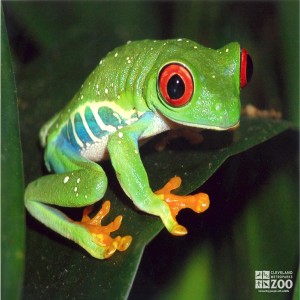Red-Eyed Tree Frog
[Agalychnis callidryas]

The red-eyed tree frog is a slender, smooth skinned, medium-sized frog, up to about 2.5 inches in length. With its combination of red eyes, bright green dorsal color, and dark blue, purple or brownish flanks with cream-colored vertical bars, it can be mistaken for no other frog. The feet are generally orange in color, with the tips of the digits expanded to form discs. The fingers are about half-webbed, while the toes are about two-thirds webbed. Males are smaller than females. Their large eyes have vertical elliptical pupils.
Location: Animals Formerly at Zoo
Share:
Range
Central Mexico to Guatemala
Habitat
Humid forests area
Conservation Status
Least ConcernPrimary Threats
Gestation
Incubation: About 45 days from tadpole to froglet
Litter
Clutch size: average 40 green eggs
Behavior
The red-eyed tree frog is common during the rainy season around pools and water-filled ditches, within or adjacent to forests. During the dry season they retreat to epiphytic bromeliads and other arboreal shelters. They are nocturnal, and search for insects among the leaves and branches of the forest trees. The call of the male is usually a single note "cluck" or "chock", repeated at spaced intervals. They have a slow, stalking movement as they creep up on their prey.
Reproduction
The red-eyed tree frog breeds in bushes and palms beginning with the first rains of the wet season (late May to November). During amplexus within the plants, the female attaches a clump averaging 40 sticky jelly-covered eggs to a leaf directly above the water. As the 1-centimeter tadpoles hatch out after 6-10 days, they fall into the water.
Wild Diet
Insects
